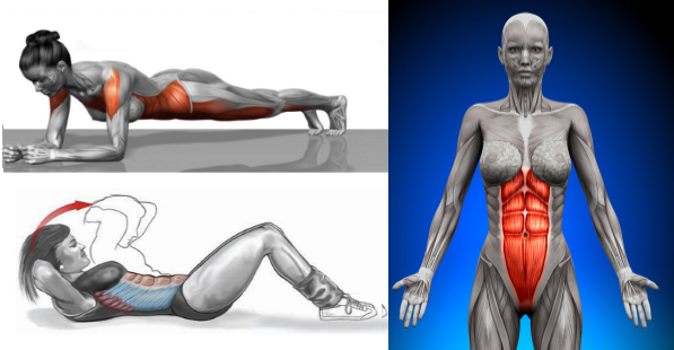«
»


Planking isn?t a dynamic exercise, per se. It works on your core stability by strengthening your core without moving to a spinal flexion or extension and that?s its entire purpose. However, planking isn?t just supporting yourself on your elbows and knees as long as possible. Planking creates tension in your core, legs and upper body and if you want to keep the tension on them you have to flex and squeeze your muscles as hard as you can while doing it.
When your core muscles are being put under pressure, you should feel your knees almost pulling towards your toes during the exercise. Planking helps strengthen your spine, which in turn will help you keep a neutral spine during your daily routine. When you do planks on a regular basis, it will bring positive effects on a number of other compound exercises such as deadlifts, benching and squats.
As opposed to that, the floor crunch and its many variations serve to get you to go into spinal extension and flexion as much as possible which will contract your abs, which in turn will break down some muscle tissue to be rebuilt later. In order for muscle tissue to break down, you have to have extension and flexion of the targeted muscle, so if you want to make a hypertrophic response in your abs, do some floor crunches.
So, should you do planks or floor crunches to build up your abs?
The answer is multifaceted. If you want your body to become more stable, do planks. If you want to have sturdy, blocky abs, do floor crunches and their variations. Of course, you can do both. Some people do crunches first in order to activate their rectus abdominis and break them down a bit, and then finish with some planks. This is done because you can exhaust your abs before doing planks, so when you actually do them they will be harder and more intensified.
Planks are really easy to do and you can do them for anywhere up to five minutes, if you?re rested. However, if you do floor crunches before working on your plank, those five minutes will be way more intense and you might not even last that long! So, all in all, the best thing to do about these two exercises is to combine them ? floor crunches first followed by planks and your abs will look amazing.
When your core muscles are being put under pressure, you should feel your knees almost pulling towards your toes during the exercise. Planking helps strengthen your spine, which in turn will help you keep a neutral spine during your daily routine. When you do planks on a regular basis, it will bring positive effects on a number of other compound exercises such as deadlifts, benching and squats.
As opposed to that, the floor crunch and its many variations serve to get you to go into spinal extension and flexion as much as possible which will contract your abs, which in turn will break down some muscle tissue to be rebuilt later. In order for muscle tissue to break down, you have to have extension and flexion of the targeted muscle, so if you want to make a hypertrophic response in your abs, do some floor crunches.
So, should you do planks or floor crunches to build up your abs?
The answer is multifaceted. If you want your body to become more stable, do planks. If you want to have sturdy, blocky abs, do floor crunches and their variations. Of course, you can do both. Some people do crunches first in order to activate their rectus abdominis and break them down a bit, and then finish with some planks. This is done because you can exhaust your abs before doing planks, so when you actually do them they will be harder and more intensified.
Planks are really easy to do and you can do them for anywhere up to five minutes, if you?re rested. However, if you do floor crunches before working on your plank, those five minutes will be way more intense and you might not even last that long! So, all in all, the best thing to do about these two exercises is to combine them ? floor crunches first followed by planks and your abs will look amazing.
Plank vs. Crunch: Which Is the Best Exercise for Abs and Core?
- By: admin
- Date: 2018.02.03 10:50
- Category: Fitness Exercises
